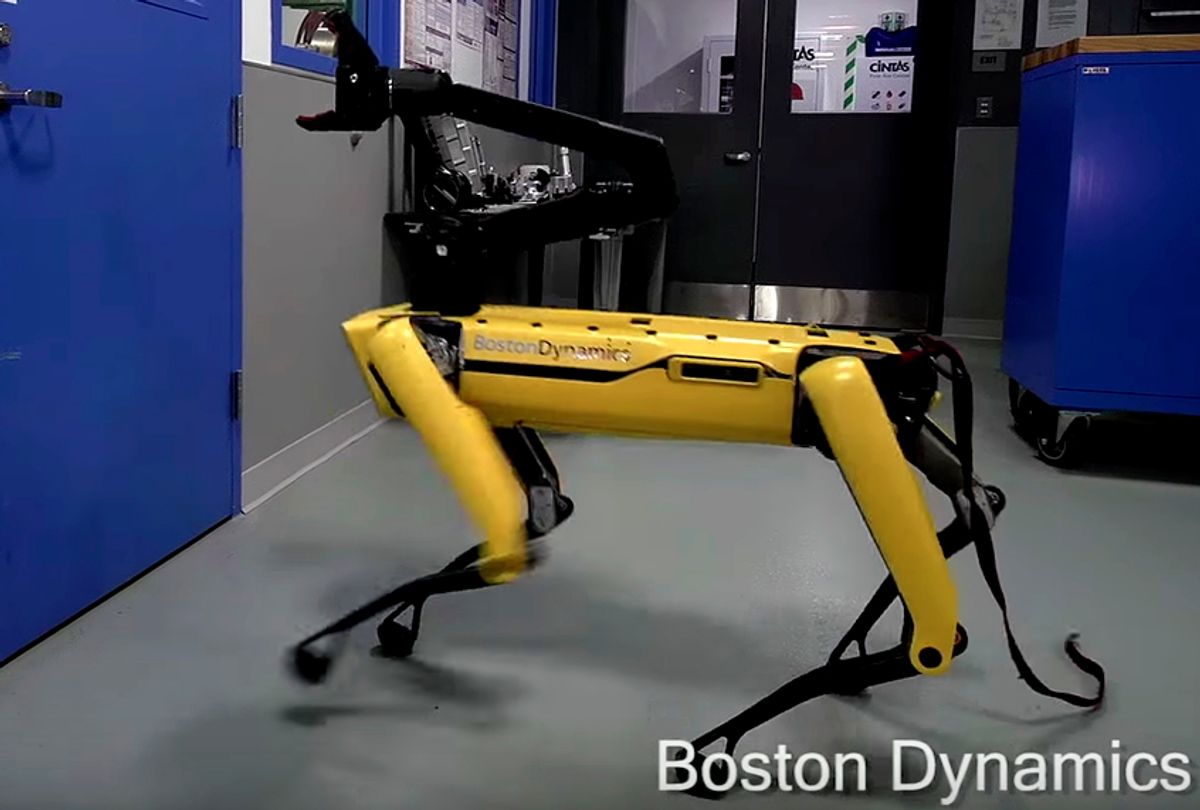If you're building technology that recalls the robot oppressors of "The Matrix" or "Black Mirror" it is probably not a good idea (from a public relations standpoint), to show off your robots' potential to bring on the apocalypse. Most Silicon Valley companies have absorbed this branding wisdom. Case in point: Google often prompts comparisons to "The Terminator's" internet-gone-haywire SkyNet, but the company wisely directs their marketing dollars in the direction of cute Google Doodles and other PR stunts to lend the company a softer, less apocalyptic edge. Likewise, if you ask Apple's voice assistant Siri, they swear they don't know HAL, the evil computer from "2001: A Space Odyssey." And Facebook, constantly in the news for its easy availability as a disinformation weapon by intelligence agencies, is now emphasizing how the platform is a place to "focus on meaningful connections."
These are sound public relations strategies from tech companies who are well-aware of their products' potential to be perceived as tools of hegemonic oppression. Apparently, many robotics researchers didn't get the memo.
Today and yesterday, we were treated to new test videos from robotics manufacturer Boston Dynamics, featuring their four-legged robots opening doors for one another, and, today, opening the same door while resisting a researcher's attempts to deflect it with a hockey stick. In the video, "Testing Robustness," the stick-wielding researcher is relatively gentle with his blunt instrument, before yanking the dogbot by its leash. Still, you get the impression he doesn't really want to hurt the robot, a model called a SpotMini for its resemblance to a dog (I'd feel more comfortable seeing a follow-up video showing how it fares against a shotgun, or a crucible full of liquid iron, or both).
The videos terrified many. "The new video of Boston Dynamics’ robot dog is even more horrifying than the first one," tech news site BGR cautioned in their headline. Devin Coldewey's headline in TechCrunch was perhaps the most prophetic: "Humans sow seeds of destruction by abusing poor robot just trying to walk through a door."
"Seems like at this point you don’t want to anger them," Coldewey wrote. "They will find you. Or rather, they’ll find the company’s designated robot abuser and punish him for stopping poor robots from doing what they have been told to do. Soon Spot Mini will not be the one on a leash."
Indeed, the SpotMini's resilience in the face of intervention, and its plodding, methodical dedication to its mission is creepily reminiscent of all kinds of sci-fi robots that wouldn't give up in their missions to seek and destroy. The trope of the indestructible robot is a sci-fi horror staple: the Terminators, every single model in every single movie in the franchise; the bullet-dodging, expressionless agents of "The Matrix;" and the unnamed "dog" robot in the episode "Metalhead" from the latest season of "Black Mirror."
In the span of that 45-minute episode, an autonomous drone robot-dog chases a terrified trespasser across a barren landscape, handily converting whatever it can find into a weapon while overcoming nearly any attempt to defeat it. The "Black Mirror" team's robot intentionally resembled the Boston Dynamics design, and prances and capers in a similar manner. Series creator Charlie Brooker admitted in an interview with Entertainment Weekly that the design of that episode's robot dog was lifted from "watching Boston Dynamics videos." "And with those [Boston Dynamics] videos, there’s something very creepy watching them where they get knocked over, and they look sort of pathetic laying there, but then they slowly manage to get back up," Brooker said.
It's reminiscent of another creepy robot that was presaged almost precisely in the third season of "Black Mirror." Episode 6, titled "Hatred in the Nation," took place in a near-future United Kingdom, where Colony Collapse Disorder (a very real thing!) had killed off much of the world's honeybee population. As modern agriculture is utterly reliant on bees as pollinators, humans in this fictional future were forced to construct artificial robot honey-bees, which appeared as tiny drones that fly from flower to flower. Yet the bees seem to be controlled by an unseen hand, and can be programmed to act as tiny assassins.
Compared to other futuristic technologies, "Hatred in the Nation" ranked right up there on the realism scale. Researchers at Japan's National Institute of Advanced Industrial Science and Technology have developed drones the size of insects that could act as "artificial pollinators." That particular "Black Mirror" episode was back in the news this week after a pair of headlines in some of the more sensationalist British tabloids, including the Daily Mirror and the Daily Star, the latter of which interviewed a researcher who claimed that the drone bees could be hacked to release a chemical sting to kill. I should note that the abilities of the drone bees are limited; one critic called the drones as they exist today "comically inept." In other words, don't fear the bee-bots just yet.
Robotics researchers must contend with the long history of fictitious evil robots that predates them. Yes, the software makers have their share of evil computers — from HAL 9000 to "Tron's" Master Control Program to "Dr. Who's" B.O.S.S. Perhaps because computers are more containable, and indeed, are jammed in every conceivable electronic device, we've learned to accept them as normal. The robots, not so much; outside of a stray Roomba, we don't have a plethora of friendly or unfriendly robots in our day-to-day lives, and many of our observations about robots are negative (Remember that homeless-policing snitchbot in San Francisco last year? That wasn't doing any favors for the robot PR people). One wonders if the roboticists are cognizant that they are fighting an uphill PR battle.



Shares